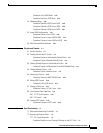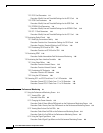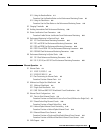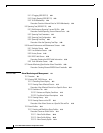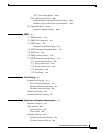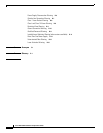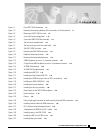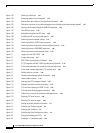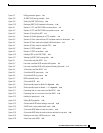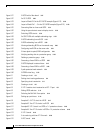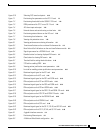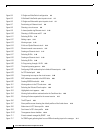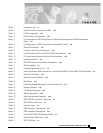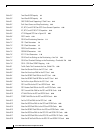
Figures
xvii
Cisco ONS 15454 Installation and Operations Guide
November 2001
Figure 3-7 Editing protection groups 3-11
Figure 3-8 An ONS 15454 timing example 3-13
Figure 3-9 Setting Up ONS 15454 timing 3-16
Figure 3-10 Displaying ONS 15454 hardware information 3-18
Figure 4-1 Scenario 1: CTC and ONS 15454s on same subnet 4-3
Figure 4-2 Scenario 2: CTC and ONS 15454s connected to router 4-4
Figure 4-3 Scenario 3: Using Proxy ARP 4-5
Figure 4-4 Scenario 4: Default gateway on a CTC computer 4-6
Figure 4-5 Scenario 5: Static route with one CTC computer used as a destination 4-7
Figure 4-6 Scenario 5: Static route with multiple LAN destinations 4-8
Figure 4-7 Scenario 6: Static route for multiple CTCs 4-10
Figure 4-8 Scenario 7: OSPF enabled 4-11
Figure 4-9 Scenario 7: OSPF not enabled 4-12
Figure 4-10 Enabling OSPF on the ONS 15454 4-13
Figure 4-11 Viewing the ONS 15454 routing table 4-16
Figure 5-1 A four-node, two-fiber BLSR 5-2
Figure 5-2 Four-node, two-fiber BLSR sample traffic pattern 5-3
Figure 5-3 Four-node, two-fiber BLSR traffic pattern following line break 5-4
Figure 5-4 A four-node, four-fiber BLSR 5-5
Figure 5-5 A four-fiber BLSR span switch 5-6
Figure 5-6 A four-fiber BLSR ring switch 5-6
Figure 5-7 BLSR bandwidth reuse 5-8
Figure 5-8 A five-node BLSR 5-9
Figure 5-9 Shelf assembly layout for Node 0 in Figure 5-8 5-10
Figure 5-10 Shelf assembly layout for Nodes 1 – 4 in Figure 5-8 5-10
Figure 5-11 Connecting fiber to a four-node, two-fiber BLSR 5-12
Figure 5-12 Connecting fiber to a four-node, four-fiber BLSR 5-12
Figure 5-13 Enabling an optical port 5-14
Figure 5-14 Setting BLSR properties 5-15
Figure 5-15 A three-node BLSR before adding a new node 5-18
Figure 5-16 A BLSR with a newly-added fourth node 5-20
Figure 5-17 A four-node BLSR before a trunk card switch 5-23
Figure 5-18 A four-node BLSR after the trunk cards are switched at one node 5-24
Figure 5-19 Deleting circuits from a BLSR trunk card 5-25
Figure 5-20 A basic four-node UPSR 5-27



